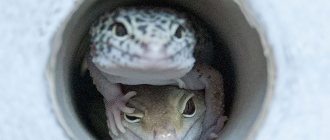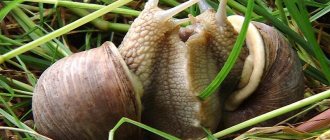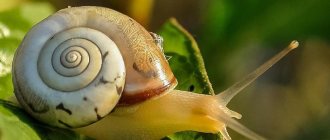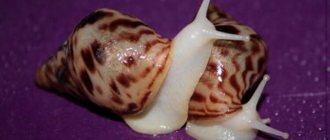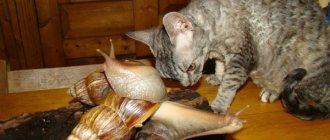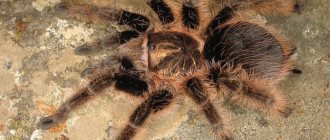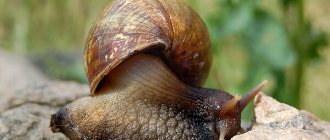Home maintenance
The leopard gecko is clean, which is very good for families with small children; you won’t have to often force the children to clean the aquarium.
They themselves determine the location of the toilet (usually in the corner), and only go there. By the way, clean animals rarely cause allergies, including leopard geckos. Characteristics of the reptile:
- Lifestyle – nocturnal;
- Body length – up to 30 cm (usually up to 20);
- The color is very diverse, from yellow to brown, about 100 colors in total. A spotted leopard pattern is a must;
- Life expectancy is up to 20 years.
The size and lifespan directly depend on the conditions of detention. In general terms, they are unpretentious, but you must try to comply with two conditions:
- Large spacious aquarium or terrarium;
- High humidity.
Spotted leopard gecko
Looking at the photo, its thick tail immediately catches your eye. There they store supplies of water, as they naturally live in the hot deserts of Afghanistan, Pakistan and parts of Iran.
In its place, of course, a new one will grow, but already thin, like that of ordinary lizards.
As for its character, the spotted leopard gecko is a very calm, balanced animal, and although it is not very smart, it becomes quite attached to a person and is happy to bask in its arms. They don't bite, so you can let children play, but warn them about the tail.
Terrarium
Not only the size and life expectancy of the reptile, but even the growth rate depends on the size and contents of the terrarium (or aquarium). Recommended dimensions are at least 50x40 cm with low walls. Volume – about 50 liters.
Terrarium for a lizard
It is very important to recreate the usual conditions inside the aquarium, but only by excluding sand. There should be a lot of ledges, snags and caves so that the lizard does not get bored, and it can explore its territory every day and hide during the day
It is useful to install a weak heater at the bottom of the aquarium so that the air inside is about 30 degrees during the day and about 25 at night. Also spray the inside of the terrarium with a spray bottle several times a day so that the humidity is around 45%.
Either one individual or a group of one male and several females (up to ten) can be kept in one terrarium. Male and male do not get along; the only way to keep them together is in a huge terrarium so that they can distribute territories.
Description of appearance
Appearance of the lizard:
- Size . The length of the animal reaches 30 cm.
- The head is quite large. The eyes are large, protruding, elongated, like those of a cat. The eyelids are very mobile.
- The body is elongated, rather elegant, covered with small scales.
- The tail is massive, thicker than that of all other representatives of lizards, and also covered with scales.
- The paws are thin, of medium length, with 5 long and round toes. They have thin claws, thanks to which lizards move along a soft surface.
- Color – usually yellow, but there may be brown spots and bumps. Juveniles have white spots on the surface. But there are also albinos.
At home, under positive conditions, the life expectancy of a leopard gecko is about 20 years or more.
Terrarium
To begin with, it is worth noting that there are two main methods of keeping leopard geckos:
Horizontal terrariums for reptiles
Terrarium
They have a more aesthetic appearance; through the glass you can observe the life of your pet; you can place various decorations and plants in it. With proper care, such a biome will be an excellent addition to your interior, which you can show to friends - plus, the leopard gecko will feel more comfortable in it. What is needed is the horizontal one, because Leopard geckos love to climb on the backgrounds on the walls, without which no such structure is usually complete, and if the terrarium is at a high altitude, they can simply fall and injure themselves.
Cage keeping
Cage system from Exo Cube
The method used by most large breeders. It is a rack with trays of various sizes. Typically, on one side of such a rack there is a heating element (mat, cord, heated floor, etc.). This method allows you to keep a large number of animals in small areas.
Minimum size of living space for one leopard gecko: 30x30x30cm For two or three leopard geckos, the area will be sufficient: 50x30x30cm It is best to keep only females together, and for males to arrange a separate home, and place the females with the male only for mating.
For cage keeping, containers from Ikea with a capacity of 11 liters, called Samla, are suitable. Its dimensions: 39 x 28 x14 cm.
They will need to have flowing ventilation, and just like with a terrarium, arrange shelters (coconut house, wet chamber) and put a toilet napkin in the corner. The heating element is placed under the tray, just as in the case of a terrarium. Temperatures can be controlled with a small thermometer, for example a Chinese one from Aliexpress.
Why you can’t keep a leopard gecko in an aquarium
Many beginners periodically make the mistake of believing that the leopard gecko can be placed in a regular fish aquarium, covered with gauze or a perforated lid. And then they don’t understand why their pets developed fungus or other specific diseases. Mold may also appear in the aquarium - which does not happen with regular flow ventilation.
The point here is that drafts are extremely dangerous for terrarium reptiles, but constantly breathing stagnant air is no less harmful for them. In humid, stale air, snakes and lizards often develop fungal and bacterial diseases of the skin, respiratory tract, as well as problems with appetite and reproduction
Therefore, it is very important to take care of creating the correct ventilation system for your scaly pets. This rule applies to most reptiles kept in captivity.
Therefore, leopard geckos cannot be kept in aquariums.
To make the aquarium suitable for leopard geckos to live in, it is not enough to simply leave its upper part open; it must have proper ventilation. This is usually done with a drill: a number of holes are made along the bottom of the aquarium, sufficient for normal air circulation. But without experience working with glass, it is better not to experiment or engage in amateur activities; it is worth asking someone who understands this for help.
It is worth noting here that using a plastic container for 200 rubles, in which you can make holes with a regular soldering iron from a fixed price, will be more correct and less expensive, and the terrarium can be purchased later, now for 2000-3000 you can buy a normal terrarium for keeping 1-2 reptiles. For example, there is a wonderful workshop of terrariums “Three Dragons” from Semphiropol, which makes and delivers terrariums of any size throughout Russia at fairly reasonable prices, a workshop at the Reptoshop store in Moscow, and many others.
In the diagram you can see the location of the ventilation relative to the heating element.
Flow ventilation diagram
Subspecies of spotted leopard gecko
Conventionally, there are 5 subspecies of the spotted leopard gecko, of which only one is recognized by all scientific communities. Animals of different groups differ in the size and number of scales on certain parts of the body.
The Afghan spotted leopard gecko (lat. Eublepharis macularius afghanicus Börner, 1976) was previously considered as a separate species. Currently this is the only recognized subspecies. Lives in Eastern, Southern Afghanistan and Northern Pakistan.
It is slightly smaller in size than other subspecies, its maximum length from the muzzle to the tip of the tail is 158-170 mm, the weight of the reptile ranges from 35-55 g. The color of the dorsal part of the body of adult individuals is bright: straw yellow or pale yellow, often with shade of pink. Blue-black spots are scattered across this background, sometimes merging into lines and forming a network. Some individuals have a white stripe running from the head to the base of the tail. There is a mesh dot pattern on the head. Young Afghans are animals with a brown or black back and 2-3 yellow transverse stripes on it. A white stripe passes through the neck in front of the ear, down to the upper lip.
Photo by: Baronak, Matt. A&M Geckos. Taken from: www.leopardgeckowiki.com
Eublepharis macularius fasciolatus Günther, 1864 lives in Southeast Pakistan.
Photo by: Cadolini, Alberto. A&M Geckos. Taken from: www.leopardgeckowiki.com
Eublepharis macularius montanus Börner, 1976 is found in South and Central Pakistan.
Photo by: Idestig, Lotta. Gekko Galaksen. Taken from: www.leopardgeckowiki.com
- Eublepharis macularius macularius (Blyth, 1854) is the nominate subspecies. Lives mainly in Pakistan, also found in North-West India.
- Eublepharis macularius smithi Börner, 1981 – endemic to Northern India.
Why is it important to preserve genetic diversity in animal lineages?
Preservation of genetic diversity serves to prevent alleles from disappearing from a population due to genetic drift and constant inbreeding. This is necessary for the survival of any species. There are several things that need to be considered to appreciate how quickly inbreeding can lead to negative consequences when developing new leopard gecko morphs. Typically, for species with short generation times (i.e. those that reach sexual maturity quickly, such as leopard geckos), this can happen quickly. However, for species with a relatively long generative period (slowly reaching maturity, for example, turtles), the negative effect is not so pronounced.
The reason we can see effects more quickly in fast-maturing species is because their generations are short and you can get 15 generations in 15 years. Turtles will need much more time for this (depending on the type of turtle), so we simply do not have time to notice the manifestations of inbreeding and genetic drift.
Breeding and caring for young animals
Leopard geckos reach sexual maturity at 9-12 months. Males are larger than females, they have a larger head and a powerful tail.
Leopard geckos should not be kept with other animals or two males together; constant territorial fights will be inevitable. Several females or a male and 2-10 girls will get along well.
If there is one male and one female, the female will most likely be tormented by the male's advances and will not live more than three years.
In captivity, leopard geckos reproduce easily. To stimulate mating, you can first worsen conditions and induce short-term hibernation, and after gradual warming, mating games quickly begin. But in principle, lizards have no prerequisites for suspended animation at home, since there is no need for it for the animal.
In order for breeding to be successful, one male and at least three females are placed in one terrarium. Extend daylight hours to 14-15 hours, increase heating to +28...+ 30 ºC and increase humidity to 60-80%.
A male, when courting a partner, often checks the composition of the air with his tongue. When ready to mate, the female friend releases special pheromones into the air. Then they begin biting the neck fold and gently stroking the female’s sides with lamps.
The eggs are small, up to 25 mm in length, and covered with a soft, leathery shell. Parents do not monitor the clutch, they only return to bury a new one.
The ripening period of eggs is about two months. Up to +26 ºC of the environment, more females are born, at +31.5 ºC male specimens predominate, in the range of +29…+30 ºC the same number of boys and girls are born. In this case, females acquire male tendencies and are not capable of reproducing offspring.
Babies are born 6-8 cm in length, weighing 5-9 g and pale striped in color; adult colors rarely appear before 7-8 months.
For newborns, incubators are pre-prepared from plastic containers, based on 0.15 sq.m. per one individual. Up to three to four months, the cubs can be safely kept together. It is convenient to use paper towels and thick napkins as bedding in containers; they are easy to change. Humidity is maintained high by regularly spraying the tank with warm water from a spray bottle, since molting still occurs every two weeks - the lizards grow quickly, and the old skin becomes too small for them.
By five months, the juveniles must be resettled. A young male can easily fertilize a female, but she is not yet ready to lay eggs.
The food used is small crickets and cockroaches of such a size that children can swallow the food.
To prevent rickets, there should always be a bowl of calcium in the incubator and an ultraviolet lamp should be turned on for a couple of minutes every two days.
Often, when kept in captivity, the mating season for Eublefar geckos shifts in time and takes place from November to March. During this time, the female can make up to ten clutches.
Pros and cons of keeping at home
The leopard gecko is an exotic pet with interesting behavior and a friendly character. Keeping this unusual pet at home has its pros and cons. Let's look at them.
Pros:
- do not cause allergies, as is often the case with cats and dogs;
- cute, calm and clean animals;
- curious and smart;
- do not require overexposure, you can safely leave the lizard alone for several days when going on vacation;
- unpretentious in care;
- quickly adapt to a new home and get used to the owners.
Minuses:
- they feed on food insects, you will have to buy them in specialized pet stores, since feeding lizards with crickets and cockroaches caught on the street is strictly unacceptable;
- They lead a nocturnal lifestyle, so the most interesting moments of a lizard’s life can only be observed in the dark.
Possible problems
- Dry, rustling skin that is difficult to remove with the leopard gecko itself - check the wet chamber. Provide sufficient moisture in the terrarium. Help with shedding if necessary.
- Unusually dense and normally soft skin that is difficult to remove is an overabundance of vitamins in the diet. Not only the lack of vitamins, but also their excess, and the second - much faster - negatively affects the health of the leopard gecko. Help your pet with shedding and reduce the dose of vitamin supplement you give during feeding. Calcium remains freely available.
- Remains of dry skin on the lizard's body - be sure to remove them by first moistening these areas. Most often, the fingers, paws, and skin under the tail are affected. Check your leopard gecko after molting, especially if there were any flaws in its maintenance or nutrition, or if your leopard gecko has a congenital tendency to heavy molting (this happens very rarely). Dry old skin sharply impairs blood circulation and your leopard gecko may be left without claws, fingers or the tip of its tail. Don't let this happen!
- Remains of skins from fights. Gently wet the bite area and the remaining skin with a wet cotton swab or a clean, damp finger (especially if your leopard gecko is tame) and rub gently - the skin will roll up and come off. Do not tear it, this may reopen the wound. Be careful.
In this photo we see two problems at the same time - a thick skin from an excess of vitamin supplements and bites on the nose and head - the consequences of fights between this male and females. Pay attention to the area around the eyes and ears - skin residues in these places can cause a lot of problems for the leopard gecko and for you, as the owner of this pet. Problematic moltingHelping the leopard gecko with moltingHelping the leopard gecko with molting
Problematic shedding
Helping leopard geckos shed
Helping the leopard gecko shed
How to determine the sex of a leopard gecko
Adult leopard geckos have several distinctive sexual characteristics. First of all, you need to pay attention to the undertail part of the body. In males, an arc of yellowish-gray dots is visible in front of the cloaca, located from one hind paw to the other - the preanal pores. At the base of the tail behind the cloacal slit it is easy to notice protruding bumps. This is where the hemipenis, the male copulatory organ, is located. In females there is a triangle in the lower abdomen, it is faintly visible. They have no pineal formations.
Also, leopard geckos of different sexes can be distinguished by the shape of the base of the tail. In males it is thick and wide, in females it is thin, resembling a waist, followed by a bushy tail. However, this sign is reliable only if the lizards have a varied, nutritious diet, which allows them to accumulate nutritional reserves in the tail part of the body. Otherwise, the thickness of the base of the tail does not matter.
Some deepening into genetics
Perhaps some of us remember the Punnett grid from school biology - a simple way to determine the results of selection in the presence of known initial genetic material (genotype). Phenotype refers to the appearance (color, size, pattern pattern, etc.) of the gecko. A homozygous gecko has two identical alleles in its genotype. Those. they carry the same characteristic.
If the alleles are different (one is dominant and the other is recessive), then such a gecko will be heterozygous, since it carries both traits. In this case, only the dominant gene will be manifested in the phenotype (appearance) of the animal. Recessive does not manifest itself, but is also inherited. When breeding geckos, in order for a recessive gene to appear, it is necessary that both parents be heterozygous and have the same gene as a recessive gene, the manifestation of which the breeder expects in his breeding work.
Only one gene may be responsible for changes in some traits in animals. It is easier to work with such signs. But there are signs for which several genes are responsible. They are called polygenic, since such traits are controlled by many genes, which can be located in different parts of the genome, and sometimes even on different chromosomes.
Some of the most popular spotted leopard gecko lines are polygenic. These are Jungles, Stripes, Tangerines and Bandits. An example of codominance (when both genes are expressed at the same time) is Mack Snows and Giants. Recessive genes are expressed in morphs such as various albino, Blizzard, Patternless and Eclipse.
One of the most colorful leopard geckos is the polygenic morph Zorro Bandit. This morph was created by crossing Jungle, Striped and Albino forms. And it is one of the most popular leopard gecko morphs abroad.
The genetics of leopard geckos is quite complex and in order to develop new morphs of leopard geckos, special knowledge is required, such as test crossing, knowledge of mutations, gene relationships and their manifestation in the phenotype, and much more, which is the subject of modern genetics. But this is an extremely interesting and exciting activity, and since more and more people are interested in it, tutorials and training programs are already appearing that help amateurs and enthusiasts create new beautiful morphs of leopard geckos.
The ability to create new combinations using different genes and new mutations is truly endless!
Tips and Tricks
There are several techniques to help a pair of leopard geckos get used to each other and carry out the process of sexual intercourse.
If an ovulating female refuses to mate, you can try to gradually introduce her to her partner's scent. To do this, take a piece of napkin located in the male’s terrarium and place it in the female’s enclosure. Over time, she will get used to the smell of a male and will become more friendly towards him when replanted.
Often males feel insecure when they are in a new tank and mating does not occur. To rectify the situation, you should try to meet the pair on male territory, or to meet the leopard geckos in a smaller container. The male is uncomfortable in a large space. The less space, the more comfortable he is.
Geckos should only be introduced facing each other. If you place a male right behind him, he will most likely bite his partner by the tail and receive a response bite from her.
Some females are not able to reproduce annually, so they experience breaks in childbearing. She needs rest to regain her strength and health.
In general, breeding spotted leopard geckos is accessible to any novice hobbyist.
Breeding leopard geckos is an exciting and promising activity that requires some preparation. To implement it, you must have at least basic knowledge about the content and seasonal life cycles of these unusual creatures; study color compatibility, matching morphs to get healthy offspring with interesting colors. The process of breeding leopard geckos is labor-intensive and time-consuming. If the breeder has these resources, then getting leopard geckos cubs is sure to be successful.
Did you learn something new? Share in the comments!
Priming
It is better to keep the juveniles on plain paper, at least until they are 10-12 cm long.
Leopard geckos are very active when feeding, and can often swallow soil while catching insects.
And in juveniles this leads to digestive problems and even death, since their intestinal lumen is much narrower than that of adults. However, you can feed them in a separate container, as in the video below.
As for sand for adults, opinions are divided: some are quite comfortable keeping geckos in the sand, others say that it is dangerous.
Apparently, the issue is the size of the sand grains; it is important to use very fine sand, 0.5 mm or less. But, if you are still concerned about your health, then pebbles, moss, special rugs for reptiles and paper are quite suitable
Masonry
Most often, the female lays eggs at night or early in the morning, burying them in the moss of a damp chamber. At first the eggs are wet and a little sticky, and then they begin to dry out and stick to the bottom of the moist chamber or to each other. Carefully transfer the eggs into the incubator without turning them over or changing their position. If the eggs have managed to stick, gently drop water onto the sticking area and wait a few minutes. Carefully separate the egg without damaging the delicate shell.
Bringing a couple together
Usually the female is placed with the male during the breeding season of leopard geckos for about a week. If fights start, place the leopard geckos; the females are not yet ready to mate. Wait 2-3 weeks and try mixing again.
From experience I can say that a male should be placed with a female (females) if he is very temperamental, combative, aggressive, and when entering a new territory with many unfamiliar smells, he will be less confident and more cautious. And the females will feel as usual, and the contact may be smoother. In his territory, such an “evil” male will feel like the master of the situation and, in a fit of passion, may bite the female.
And if your male has a very calm temperament, such a melancholic person in life, then it is better to put the female in his terrarium before cleaning, so that there are as few changes as possible in the “apartment”. On my farm there are both described types of male leopard geckos, they are very different and build relationships with their females differently.
Whether it is worth keeping a male and female leopard gecko together at all times is an individual and controversial issue; we will discuss it in a separate article.
At what age can the sex of a leopard gecko be determined?
The sex of a leopard gecko can be determined starting from 4 months. By this time, males have developed all sexual characteristics. The same cannot be said about females - they are not physiologically ready for childbearing. Their fertile age occurs after a year. Therefore, it is better to keep teenage leopard geckos separately from females to avoid fights and injury.
The sex of reptiles is directly affected by the temperature of the eggs in the incubator, so by adjusting it yourself, there is a high probability of getting offspring of the desired sex.
In newborn animals, you can try to determine the sex using a flashlight (Rob Wagner's method). To do this, it is necessary to highlight the cloaca area. In males, the veins of the hemipenes should be visible in the light.
Buying a leopard gecko
This lizard breeds well in captivity, and you can look for advertisements on Avito or simply in the local newspaper. Also in large cities there are clubs for lovers of this exotic animal, which also put them up for sale. As a rule, the spotted gecko is an infrequent guest in pet stores without prior ordering, but at the same time, it is not a super scarce reptile.
It is very important to correctly determine the gender before purchasing. Sexual differences in lizards
Sexual differences in lizards
Up to six months, until sexual maturity has occurred, the males will coexist peacefully, but when the instinct for procreation comes, a fight will begin, it is better to exclude this immediately.
The price for a lizard starts from 1,500 rubles.
Feeding the leopard gecko
The lizard is predatory, and prefers to eat insects, their larvae, newborn mice, and everything that corresponds to these sizes
It is very important to feed it with live food so that it has the opportunity to hunt. Cockroaches, crickets, grasshoppers - and the lizard will thank you
Live food for lizards
You need to feed once every day, but if the animal is stressed, then the lizard may refuse to eat for several days. Don’t worry, she has a sufficient reserve in her tail, the hunger strike does not last long.
Live food should be alternated with dry food, approximately 50/50, to which it is useful to add calcium. This can be either dried insects or industrial reptile food in any pet store. Alternatively, you can place live food (for example, larvae) in a jar of calcium, shake it, and then give it to them to eat.
An approximate portion for an adult lizard is 7 large two-centimeter crickets per day. Also, the aquarium must have a bowl of fresh water, which must be updated daily.
Lizard Breeding
If you need offspring, it is better to temporarily purchase an additional terrarium, in which we place the female for several days. Separation stimulates them to the mating season.
Couple of future parents
After 5 days, we plant the female back (but in no case the male, he must always be on his territory), and if the male shows aggression, then we plant him again for three days. If the male begins to vibrate his tail and click, then he is ready to become a father.
During the mating season, the male will lightly bite the female, but there is nothing scary or dangerous about this. After the mating process, it is recommended to transplant the female again, but if the terrarium is large, then you can leave it.
If the female is pregnant for the first time in her life, then she will carry eggs for about one and a half months. When she starts trying to dig a hole at the bottom of the terrarium, this is a sign that she is ready to lay eggs. She will also stop eating.
Formed eggs
Place a closed container filled with moist soil or coconut shavings in a corner. Make a small hole on one side of the container. The height of the soil is about 5 cm, in which the female will bury the clutch.
Lizard clutch
Incubation lasts from 45 to 70 days, depending on temperature. If the temperature is 30 degrees, then the young will be born quickly, after 45 days, and will consist only of boys. If the temperature is 27 degrees, then small lizards will appear in 2 months, and only girls.
During the season, the female will lay no more than four pairs of eggs, approximately every 3 weeks. She no longer needs a male; the mating process will be needed only in a year.
Carefully monitor the condition of the female, as pregnancy greatly depletes her body. If there is little calcium in the diet, or small portions, then the lizard will be lethargic with a sickly appearance, and in this case it is necessary to lower the temperature to 20 degrees to stop procreation (imitation of wintering). When she gains strength, she will be placed next to the male again. The second and subsequent pregnancies will pass much faster, in 3-4 weeks.
And remember - we are responsible for those we have tamed!
Features of character and lifestyle
Photo: Leopard gecko lizard
Leopard geckos are friendly lizards that are nocturnal. In the wild, during the daytime they hide in dug shelters, under stones and other objects. At night, they go out into the open, where they disguise themselves as their surroundings and wait for prey. Leopard geckos have become popular pets due to their personalities. They are not at all aggressive towards humans, they will never bite and will not be afraid (if, of course, you handle the lizard correctly). They are ideal for keeping in homes where there are other friendly animals or children.
In the wild, leopard geckos are solitary, but in terrariums you can keep them in pairs. The main thing is not to place several males in the terrarium, since they will constantly divide the territory, fight and may even injure each other. In the wild, males behave in a similar way: they protect the territory from attacks by other males. Each male’s territory is inhabited by a certain number of females, but they can move freely through different territories. One male and several females get along well in a terrarium.
As shelters, you should add bark, stones, and fixed pieces of trees to the terrarium, where the lizard can hide during the day. But they quickly adapt to a different way of life, especially if the leopard gecko was born in captivity. Then they willingly contact people during the day, feed in the morning, and sleep at night.
What to feed your spotted leopard gecko?
In nature, “leopards” mainly hunt insects, but sometimes they can prey on their own kind, only smaller ones.
The favorite food of spotted leopard geckos at home is crickets (house, banana, two-spotted). The Turkmen cockroach (Shelfordella tartara) has also proven itself well as a food item, since it is very soft and easily reproduces, without requiring special conditions. While eating it, the leopard gecko even squints with pleasure.
Marbled cockroaches (Nauphoeta cinerea) and larvae of Madagascar cockroaches (Gromphadorhina portentosa) are good eaters. Mealworms (Tenebrio molitor) can also be included in the diet of leopard geckos.
Before serving, it is advisable to feed the insects with various greens, and then sprinkle them with vitamins for reptiles or calcium powder (this is especially important for females during the breeding season). Some individuals will not refuse newborn mice, but it is not worth giving them often. Do not forget that the gecko is still an insectivorous reptile.
Spotted leopard geckos do not eat various fruits, berries and other vegetation.
Feeding your leopard gecko is quite exciting. It is advisable to present food to it by hand or with tweezers: this way the reptile will get its portion and will not swallow pebbles when hunting, and you will be sure that there are no cockroaches in the terrarium that could escape and lead a wild lifestyle in your apartment. Moreover, the leopard gecko will be happy to accept the offered food in this form. In addition, feeding by hand will speed up the process of taming the animal. “Hunting” for food, the gecko stands on outstretched paws and briefly taps its tail.
In the summer, various orthoptera (Orthoptera) from the families of grasshoppers (Tettigoniidae) and locusts (Acrididae) can be caught in the lizard meadow. This should be done away from agricultural fields and vegetable gardens, as insects can be poisoned by pesticides. If you feed grasshoppers, crush the head before feeding large ones, as grasshoppers have strong jaws that can injure your pet.
Leopard geckos older than one year are fed 2-3 times a week. An adult gecko can eat an average of 5 crickets per feeding.
The feeding regime of young people is different. Very small geckos under the age of 1 month are fed 1-2 times a day - 1 cricket per feeding is enough for them. Lizards from 1 to 3 months old are fed once a day - given 2 crickets. At the age of 3 to 6 months, leopard geckos are fed every other day - on average 1-3 large crickets per feeding. And for animals from six months to a year, it is enough to give food 2-3 times a week in the amount of 3-4 large crickets at a time.
There must be a drinking bowl with water in the terrarium. In this case, it is good to use a Petri dish with low edges. The water must be renewed at least every other day.
How is pregnancy progressing?
The first thing that will be interesting to find out is whether the mating was successful and whether it is worth preparing for the appearance of offspring. Nothing much will happen in the first few days. And then, if you look at the female’s belly, you can clearly see the maturing eggs. They are located almost symmetrically on either side of the midline of the abdomen and appear as opaque white spots.
It is very important to provide the female with adequate nutrition, since “growing” and bearing eggs requires a lot of resources from her. Feed items need to be coated with vitamin and mineral supplements, and access to calcium supplements can be provided even around the clock. It is also necessary to protect the female from stress, not to move her to another terrarium unless absolutely necessary, and, in general, to ensure her peace.
Gestation of eggs can last up to 1.5 months, but by the second week after mating you should have everything ready for laying, since it can occur in two weeks.
The main signs by which you can understand that masonry is approaching:
- Against the backdrop of general well-being, the female’s appetite decreased or completely disappeared.
- When examining the female's abdomen, it is clear that the eggs have sunk down.
- A few days before laying, the female usually digs the substrate in a damp chamber, preparing a nest for herself.
But there is no need to wait for the female to demonstrate her readiness to lay eggs - already in the first days after you separated her from the male, you need to prepare an incubator. By the time of laying, you will probably check it several times and make sure that it is properly constructed, holds the temperature correctly, is sufficiently humidified, and the incubation of eggs will not be accompanied by various “technical surprises.”
Pet care
Leopard geckos need air humidity for easy molting. These lizards shed periodically. First, the lizard's body fades and then becomes completely white. When the head also becomes white, the leopard geckos begin to tear off their old skin. New, bright skin is visible underneath.
It leads a nocturnal and twilight lifestyle, hiding during the day under stones and in caves.
Thanks to the moist air, this process proceeds without problems, and no dried pieces of old skin remain on the bodies. If even a tiny piece remains on the body, it should be immediately removed with tweezers, moistened with warm water, otherwise the lizard may develop a skin disease. But treating skin problems in leopard geckos is not at all easy.
In terms of health, care should be taken with these reptiles
The terrarium should have a drinking bowl with clean water, which is changed every 2 days. Leopard geckos love to drink a lot, and at the same time they lap up the water with their tongue, the word cats. These lizards are very clean, so they only go to the toilet in a certain part of the terrarium. The area should be cleaned regularly, removing feces and adding new pebbles.
Reptile feces should be brown and not runny. When upset, leopard geckos are given enterosgel. If the medicine does not help, you will need to consult a veterinarian, as these lizards have a very sensitive stomach and intestines. They may even experience rectal prolapse, and if surgery is not performed, the animal may die.
Feed and nutrition
In nature, leopard geckos feed mainly on various insects, spiders and small lizards, and do not disdain their young. Crickets and small cockroaches are recognized as the most optimal food at home. They love to eat mealworms and zofobas, but this is a very fatty food, so you should not abuse it, otherwise obesity may occur, which will adversely affect both the health of the animal and its reproductive abilities. Insects in the summer include grasshoppers, locusts, and green caterpillars of butterflies not covered with hairs; they, like brightly colored ones, can be poisonous. And don’t forget - if you feed insects of unknown origin, there is always a risk that the animal may suffer. Most natural insects have mites, worms and other parasites, therefore, if you give your pet food of natural origin in the summer, it is recommended that you give it prophylaxis against parasites at the end of the season. Earthworms can also be dangerous. It is strictly forbidden to give maggots - the animal may die, since they have an external digestive system and can begin to digest the animal while inside it. Some adult animals love small pieces of sweet fruit, but giving citrus fruits is not recommended, as they may cause indigestion. During breeding, females can be given pebbles (newborn mice) to maintain good shape, but not all animals eat them. A newborn leopard gecko may not eat for the first week - first it will eat its umbilical cord, then its skin after the first moult. Only after his internal organs begin to function and he has digested everything can you begin to feed him. This can be judged by the small poops that appear nearby.
Drawing your own line
To maintain the purity of the line, breeders use linear crossing (reproduction of the morph by crossing only purebred individuals with a homozygous genotype for breed characteristics). At the same time, in each generation the best individuals are selected, with the most pronounced breed characteristics. Only such, the best individuals are used further for reproduction within this line.
For example, there are many different lines of tangerine geckos, each with a slightly different appearance, structure or coloration. Many breeders take the best Tangerine individuals from different lines, cross them to combine their genotypes, improve and develop their own Tangerine line. Tangerine lines are known for their robust build and unique coloring. Therefore, many breeders continue to refine various Tangerine lines to create their own morph of leopard geckos.
Changes in skin color, eyes and body patterns are one of the most popular areas for breeding new breed lines. Many color variations and patterns can be obtained depending on the presence of the corresponding genes in the genotype.
